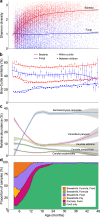Temporal changes in gastrointestinal fungi and the risk of autoimmunity during early childhood: the TEDDY study
- PMID: 35672407
- PMCID: PMC9174155
- DOI: 10.1038/s41467-022-30686-w
Temporal changes in gastrointestinal fungi and the risk of autoimmunity during early childhood: the TEDDY study
Abstract
Fungal infections are a major health problem that often begin in the gastrointestinal tract. Gut microbe interactions in early childhood are critical for proper immune responses, yet there is little known about the development of the fungal population from infancy into childhood. Here, as part of the TEDDY (The Environmental Determinants of Diabetes in the Young) study, we examine stool samples of 888 children from 3 to 48 months and find considerable differences between fungi and bacteria. The metagenomic relative abundance of fungi was extremely low but increased while weaning from milk and formula. Overall fungal diversity remained constant over time, in contrast with the increase in bacterial diversity. Fungal profiles had high temporal variation, but there was less variation from month-to-month in an individual than among different children of the same age. Fungal composition varied with geography, diet, and the use of probiotics. Multiple Candida spp. were at higher relative abundance in children than adults, while Malassezia and certain food-associated fungi were lower in children. There were only subtle fungal differences associated with the subset of children that developed islet autoimmunity or type 1 diabetes. Having proper fungal exposures may be crucial for children to establish appropriate responses to fungi and limit the risk of infection: the data here suggests those gastrointestinal exposures are limited and variable.
© 2022. The Author(s).
Conflict of interest statement
The authors declare no competing interests.
Figures


Similar articles
-
Fungal diversity in the gut microbiome of young South African children.BMC Microbiol. 2022 Aug 17;22(1):201. doi: 10.1186/s12866-022-02615-w. BMC Microbiol. 2022. PMID: 35978282 Free PMC article.
-
Association of Early Exposure of Probiotics and Islet Autoimmunity in the TEDDY Study.JAMA Pediatr. 2016 Jan;170(1):20-8. doi: 10.1001/jamapediatrics.2015.2757. JAMA Pediatr. 2016. PMID: 26552054 Free PMC article.
-
Investigating Colonization of the Healthy Adult Gastrointestinal Tract by Fungi.mSphere. 2018 Mar 28;3(2):e00092-18. doi: 10.1128/mSphere.00092-18. eCollection 2018 Mar-Apr. mSphere. 2018. PMID: 29600282 Free PMC article.
-
Review article: fungal alterations in inflammatory bowel diseases.Aliment Pharmacol Ther. 2019 Dec;50(11-12):1159-1171. doi: 10.1111/apt.15523. Epub 2019 Oct 24. Aliment Pharmacol Ther. 2019. PMID: 31648369 Review.
-
The Environmental Determinants of Diabetes in the Young (TEDDY) Study: 2018 Update.Curr Diab Rep. 2018 Oct 23;18(12):136. doi: 10.1007/s11892-018-1113-2. Curr Diab Rep. 2018. PMID: 30353256 Free PMC article. Review.
Cited by
-
Gut Mycobiome: Latest Findings and Current Knowledge Regarding Its Significance in Human Health and Disease.J Fungi (Basel). 2025 Apr 22;11(5):333. doi: 10.3390/jof11050333. J Fungi (Basel). 2025. PMID: 40422666 Free PMC article. Review.
-
Divergent maturational patterns of the infant bacterial and fungal gut microbiome in the first year of life are associated with inter-kingdom community dynamics and infant nutrition.Microbiome. 2024 Feb 7;12(1):22. doi: 10.1186/s40168-023-01735-3. Microbiome. 2024. PMID: 38326891 Free PMC article.
-
Possible heterogeneity of initial pancreatic islet beta-cell autoimmunity heralding type 1 diabetes.J Intern Med. 2023 Aug;294(2):145-158. doi: 10.1111/joim.13648. Epub 2023 May 14. J Intern Med. 2023. PMID: 37143363 Free PMC article. Review.
-
Commensal fungi in intestinal health and disease.Nat Rev Gastroenterol Hepatol. 2023 Nov;20(11):723-734. doi: 10.1038/s41575-023-00816-w. Epub 2023 Jul 21. Nat Rev Gastroenterol Hepatol. 2023. PMID: 37479823 Review.
-
Maternal consumption of urbanized diet compromises early-life health in association with gut microbiota.Gut Microbes. 2025 Dec;17(1):2483783. doi: 10.1080/19490976.2025.2483783. Epub 2025 Apr 2. Gut Microbes. 2025. PMID: 40176259 Free PMC article. Review.
References
Publication types
MeSH terms
Grants and funding
- U01 DK063821/DK/NIDDK NIH HHS/United States
- UC4 DK063863/DK/NIDDK NIH HHS/United States
- UL1 TR002535/TR/NCATS NIH HHS/United States
- HHSN267200700014C/DK/NIDDK NIH HHS/United States
- U01 DK063790/DK/NIDDK NIH HHS/United States
- UL1 TR000064/TR/NCATS NIH HHS/United States
- U01 DK063836/DK/NIDDK NIH HHS/United States
- U01 DK063829/DK/NIDDK NIH HHS/United States
- U01 DK063865/DK/NIDDK NIH HHS/United States
- UC4 DK095300/DK/NIDDK NIH HHS/United States
- UC4 DK063861/DK/NIDDK NIH HHS/United States
- UC4 DK063829/DK/NIDDK NIH HHS/United States
- UC4 DK063821/DK/NIDDK NIH HHS/United States
- UC4 DK117483/DK/NIDDK NIH HHS/United States
- UC4 DK063836/DK/NIDDK NIH HHS/United States
- UC4 DK112243/DK/NIDDK NIH HHS/United States
- U01 DK124166/DK/NIDDK NIH HHS/United States
- U01 DK063861/DK/NIDDK NIH HHS/United States
- P30 ES030285/ES/NIEHS NIH HHS/United States
- U01 DK128847/DK/NIDDK NIH HHS/United States
- UC4 DK063865/DK/NIDDK NIH HHS/United States
- U01 DK063863/DK/NIDDK NIH HHS/United States
- UC4 DK106955/DK/NIDDK NIH HHS/United States
- UC4 DK100238/DK/NIDDK NIH HHS/United States
LinkOut - more resources
Full Text Sources
Medical
Miscellaneous

